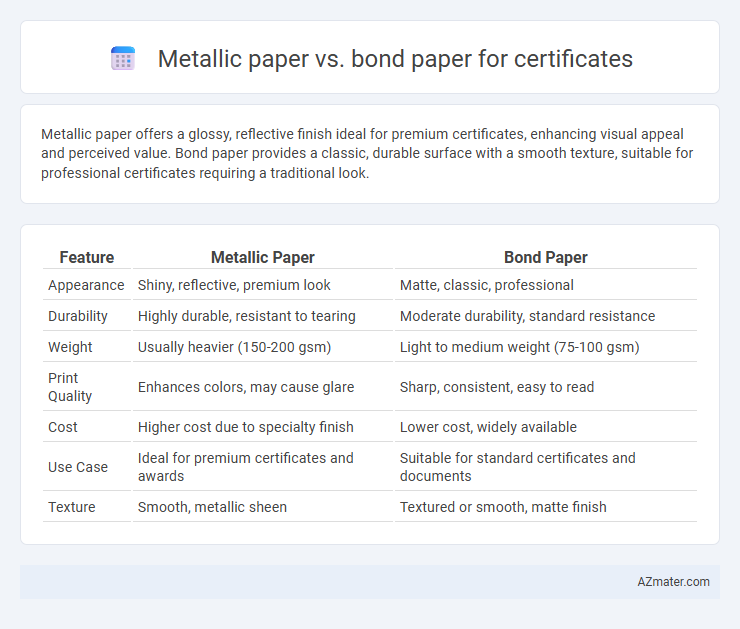Metallic paper offers a glossy, reflective finish ideal for premium certificates, enhancing visual appeal and perceived value. Bond paper provides a classic, durable surface with a smooth texture, suitable for professional certificates requiring a traditional look.
Table of Comparison
| Feature | Metallic Paper | Bond Paper |
|---|---|---|
| Appearance | Shiny, reflective, premium look | Matte, classic, professional |
| Durability | Highly durable, resistant to tearing | Moderate durability, standard resistance |
| Weight | Usually heavier (150-200 gsm) | Light to medium weight (75-100 gsm) |
| Print Quality | Enhances colors, may cause glare | Sharp, consistent, easy to read |
| Cost | Higher cost due to specialty finish | Lower cost, widely available |
| Use Case | Ideal for premium certificates and awards | Suitable for standard certificates and documents |
| Texture | Smooth, metallic sheen | Textured or smooth, matte finish |
Introduction to Metallic Paper and Bond Paper
Metallic paper features a reflective, shiny finish that enhances the vibrancy and prestige of certificates, making them visually striking and ideal for awards or special recognitions. Bond paper, known for its durability and smooth texture, offers a professional and classic appearance commonly used for official documents and certificates requiring a formal tone. Both papers differ in weight and finish, with metallic paper typically heavier and more eye-catching, while bond paper balances quality with practicality for everyday use.
Key Differences Between Metallic and Bond Paper
Metallic paper offers a glossy, reflective finish that enhances the visual appeal of certificates with vibrant colors and a premium look, while bond paper provides a smooth, matte surface known for durability and a professional, classic appearance. Metallic paper is often thicker and less flexible, making it ideal for special awards and presentations, whereas bond paper is lighter and easier to handle, suitable for everyday certification needs. The choice between the two hinges on the desired aesthetic impact and functional use, with metallic paper excelling in eye-catching designs and bond paper favored for reliability and traditional print quality.
Appearance and Visual Impact
Metallic paper offers a glossy, reflective surface that enhances the vibrancy and depth of colors, making certificates stand out with a premium, eye-catching finish. Bond paper, while more traditional and matte, provides a clean and professional look but lacks the shimmering effect of metallic paper. The choice between metallic and bond paper significantly influences the visual impact, with metallic paper delivering a more luxurious and memorable presentation for certificates.
Texture and Feel
Metallic paper for certificates offers a glossy, reflective surface that provides a smooth and luxurious texture, enhancing the visual appeal with its shimmering finish. Bond paper features a more traditional, matte texture with a slightly rougher feel, known for its durability and professional appearance. The choice between metallic and bond paper ultimately affects the tactile experience and overall prestige conveyed by the certificate.
Durability and Longevity
Metallic paper offers enhanced durability and longevity compared to bond paper due to its resistance to fading, water, and physical wear, making it ideal for certificates meant to last. Bond paper, while cost-effective and widely used, is more prone to yellowing and tearing over time under environmental stress. Certificates printed on metallic paper maintain crisp colors and structural integrity for decades, providing a more premium and lasting presentation.
Print Quality and Color Vibrancy
Metallic paper delivers superior print quality and exceptional color vibrancy, enhancing certificate designs with a luminous sheen and sharp detail. Compared to bond paper, metallic paper's reflective surface intensifies hues and contrast, making text and graphics more prominent. Bond paper offers a smoother, matte finish but lacks the vivid color saturation and dynamic visual impact provided by metallic paper.
Cost Comparison: Metallic vs Bond Paper
Metallic paper typically costs 2 to 3 times more than bond paper due to its specialty coating and reflective finish, making it a premium choice for certificates requiring a high-end appearance. Bond paper, commonly priced between $0.02 to $0.10 per sheet, offers an economical and widely available option for bulk certificate printing without sacrificing durability. Budget-conscious projects often favor bond paper for its lower cost and acceptable quality, while metallic paper suits limited runs demanding a more luxurious presentation.
Suitability for Certificates and Awards
Metallic paper enhances certificates and awards with a shimmering, premium finish ideal for prestigious recognitions. Bond paper offers durability and a classic, professional appearance suitable for everyday awards and document longevity. Choosing between metallic and bond paper depends on the desired aesthetic impact and the formality of the certificate or award.
Environmental Considerations
Metallic paper for certificates often contains synthetic coatings and aluminum layers, making it less biodegradable and challenging to recycle compared to bond paper, which is typically produced from natural fibers like wood pulp and has higher recyclability. Bond paper's biodegradable nature and lower environmental impact make it a more sustainable choice for certificates, especially when sourced from recycled or FSC-certified materials. Choosing bond paper reduces landfill waste and decreases the carbon footprint associated with paper production and disposal, highlighting its eco-friendly advantage over metallic paper.
Choosing the Right Paper for Your Certificate
Metallic paper offers a glossy, reflective finish that enhances the visual appeal of certificates, making them ideal for awards or special recognitions, while bond paper provides a classic, durable texture suitable for everyday certificates and official documents. Key factors in choosing the right certificate paper include the level of formality, desired durability, and the printing method, with metallic paper working best with laser printers and bond paper compatible with most inkjet and laser printers. Prioritizing paper weight is essential; metallic paper typically ranges from 150-200 gsm for sturdiness, whereas bond paper ranges from 80-120 gsm, balancing cost and quality for bulk certificate printing.

Infographic: Metallic paper vs Bond paper for Certificate
 azmater.com
azmater.com